跨文化交际 教材P288 中文翻译
跨文化交际与翻译
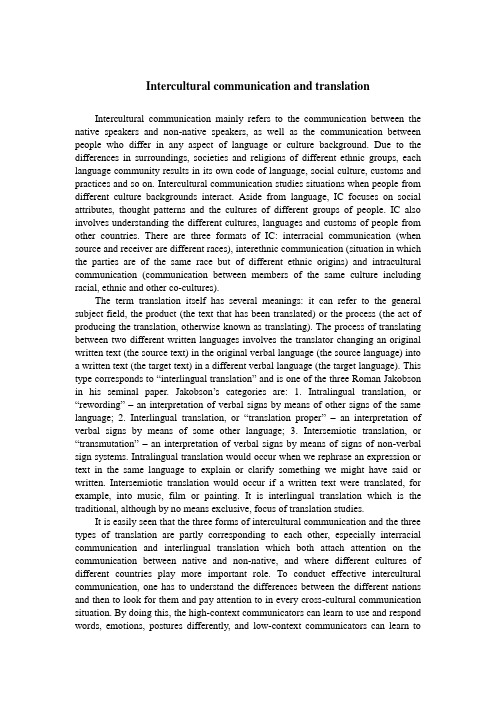
Intercultural communication and translation Intercultural communication mainly refers to the communication between the native speakers and non-native speakers, as well as the communication between people who differ in any aspect of language or culture background. Due to the differences in surroundings, societies and religions of different ethnic groups, each language community results in its own code of language, social culture, customs and practices and so on. Intercultural communication studies situations when people from different culture backgrounds interact. Aside from language, IC focuses on social attributes, thought patterns and the cultures of different groups of people. IC also involves understanding the different cultures, languages and customs of people from other countries. There are three formats of IC: interracial communication (when source and receiver are different races), interethnic communication (situation in which the parties are of the same race but of different ethnic origins) and intracultural communication (communication between members of the same culture including racial, ethnic and other co-cultures).The term translation itself has several meanings: it can refer to the general subject field, the product (the text that has been translated) or the process (the act of producing the translation, otherwise known as translating). The process of translating between two different written languages involves the translator changing an original written text (the source text) in the original verbal language (the source language) into a written text (the target text) in a different verbal language (the target language). This type corresponds to “interlingual translation” and is one of the three Roman Jakobson in his seminal paper. Jakobson’s categories are: 1. Intralingual translation, or “rewording”– an interpretation of verbal signs by means of other signs of the same language; 2. Interlingual translation, or “translation proper”–an interpretation of verbal signs by means of some other language; 3. Intersemiotic translation, or “transmutation”– an interpretation of verbal signs by means of signs of non-verbal sign systems. Intralingual translation would occur when we rephrase an expression or text in the same language to explain or clarify something we might have said or written. Intersemiotic translation would occur if a written text were translated, for example, into music, film or painting. It is interlingual translation which is the traditional, although by no means exclusive, focus of translation studies.It is easily seen that the three forms of intercultural communication and the three types of translation are partly corresponding to each other, especially interracial communication and interlingual translation which both attach attention on the communication between native and non-native, and where different cultures of different countries play more important role. To conduct effective intercultural communication, one has to understand the differences between the different nations and then to look for them and pay attention to in every cross-cultural communication situation. By doing this, the high-context communicators can learn to use and respond words, emotions, postures differently, and low-context communicators can learn topay attention to context and learn to interpret meaning in terms of the context. It is evident that different countries or nations have quite different customs, cultures, ways to express emotions and so on, to become successful communicator and avoid serious culture shock and failure, it’s essential to have intercultural knowledge about low context, high context, power distance and other information, to eradicate stereotypes, to hold placid attitude, to know that cultures are different.And there was no doubting translation is an intercultural activity. The culture of source text can only find echoes from source language readers, however, for target language readers, the lack of similar cultural background may lead to the loss of ingenuity of the originals. Translation as a tool of communication is thus a significant intercultural activity aiming at breaking the language and culture barriers and enriching communication. To become a successful translator or interpreter, learning culture difference is an inevitable aspect of training. Translation texts are the product of the mutual influence of source language culture and target language culture. The properties, extent and concrete level of the two languages and cultures are to some degree influencing the choice of translation strategies, syntactic structures and words of the translators. Thus culture as a dispensable capability of a translator, of conducting effective translation makes translation resemble to intercultural communication.Effective intercultural communication cannot be accomplished at one stroke, and it is impossible to do successful translation without knowledge of cultures. To stride across the cultural barriers of different nations, it’s necessary to adjust the attitude of intercultural communication, and recognize the discrepancy of translation strategies, so to reconstruct the artistic sense of originals, and appeal to more target readers with vigorous translation. Knowing better the relationship between intercultural communication and translation is of great importance to these two practices.。
跨文化交际英语 阅读教程3课文翻译

第一单元现代社会依赖于技术创新,而技术创新须依靠知识产权来保障。
越来越多的国家遵守国际条约,实行知识产权保护。
但这方面做得还远远不够。
我们来回顾一下过去,看看缺乏知识产权保护会导致什么样的后果,从而吸取教训。
许多西方公司付出了惨痛的代价才发现,知识产权保障机制还未健全时,在东南亚投资无异于将钱付诸东流。
要进入这些市场,西方公司不仅必须向相关当局说明他们的产品,而且还要说明他们产品的制作过程。
而结果经常是本该受到知识产权保护的产品很快被无耻地抄袭。
盗用知识产权的例子不胜枚举。
例如,美国化学制品巨头杜邦向一亚洲国家引进了一种名叫Londax的著名除草剂,用来除掉稻田里的杂草。
该公司在该产品的研发上投资了数百万美元,而且又投入了2500万美元在当地开设了一家生产厂家。
然而,不到一年以后,一瓶瓶非常廉价的冒牌Londax公然上市了。
冒牌产品和正宗产品除了价格外的唯一区别是冒牌产品的名称是Rondex,用的是蓝色瓶而不是正宗产品用的绿色瓶。
但是,由于冒牌产品的价格比正宗产品的价格低廉许多,它成功毁掉了杜邦公司的投资。
同时它也使得该公司不再愿意投资于新化学制品的研发。
生产Londax的配方本应该被当作是杜邦公司的知识产权。
其他非法使用该配方的公司是犯了偷盗行为,就像盗取了杜邦公司的机器或者该公司的其他财产一样。
不光是产品,在亚洲市场上保护一个品牌也曾经是几乎不可能的事。
就连Kellogg’s玉米片的生产商Kel logg’s公司也发现自己的产品被山寨:Kongal 牌玉米条,连包装也几乎一模一样。
不幸的是,和杜邦公司的事件一样,Kellogg’s 公司成功惩罚侵权者的几率几乎为零,因为当地的法律不承认知识产权保护的概念。
幸好,在经过许多轮世贸组织的谈判后,情况大为改观。
然而,跨国公司必须保持警惕,以防被侵权。
总有人试图从别人的研发、投资、商誉中牟利。
如果成果得不到法律保护,创新就是空话。
如今你经常会听到“知识产权”这个词——通常是从产权者嘴里。
(完整word版)《跨文化交际英语实用教程》名词解释

《跨文化交际英语实用教程》名词解释Define the following terms:1. Culture: it refers to a learned set of shared interpretations about beliefs, values,norms and social practices, which affect the behaviors of a relatively large group of people.文化:它是指一组学习者对信仰、价值观、规范和社会实践的共同理解,从而影响了一个相对大的群体的行为。
2. Intercultural communication:It is communication between people from different cultural backgrounds, or it refers to communication between people whose cultural perceptions and symbol systems are distinct enough to alter the communication event.跨文化交际:它是来自不同文化背景的人们之间的交流,也就是说,人们的文化观念和符号系统之间的沟通是不同的,足以改变交际活动。
3. Denotative meaning tends to be described as the definitional,literal,obvious or commonsense meaning of a word.外延意义往往被描述为定义,文字,一个词明显或常识性的意义。
4. Connotative meaning is used to refer to the socio—cultural associations of the word.内涵意义是指词的社会文化协会。
跨文化交际翻译
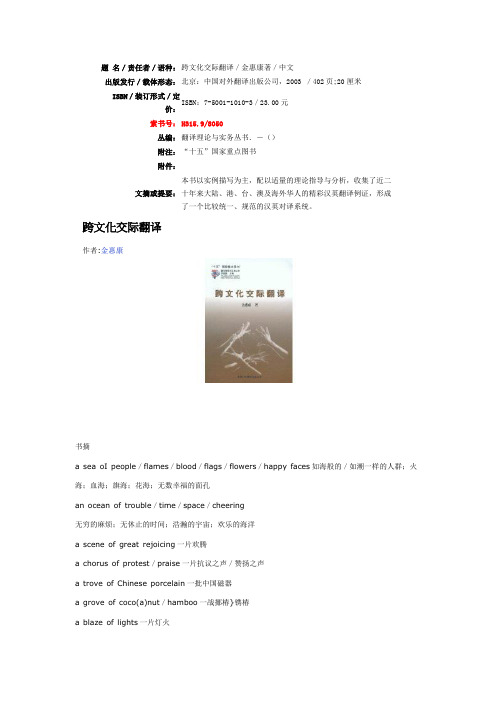
题名/责任者/语种:跨文化交际翻译/金惠康著/中文出版发行/载体形态:北京:中国对外翻译出版公司,2003 /402页;20厘米ISBN/装订形式/定价:ISBN:7-5001-1010-3/23.00元索书号:H315.9/8050丛编:翻译理论与实务丛书.-()附注:“十五”国家重点图书附件:文摘或提要:本书以实例描写为主,配以适量的理论指导与分析,收集了近二十年来大陆、港、台、澳及海外华人的精彩汉英翻译例证,形成了一个比较统一、规范的汉英对译系统。
跨文化交际翻译作者:金惠康书摘a sea oI people/flames/blood/flags/flowers/happy faces如海般的/如潮一样的人群;火海;血海;旗海;花海;无数幸福的面孔an ocean of trouble/time/space/cheering无穷的麻烦;无休止的时间;浩瀚的宇宙;欢乐的海洋a scene of great rejoicing一片欢腾a chorus of protest/praise一片抗议之声/赞扬之声a trove of Chinese porcelain一批中国磁器a grove of coco(a)nut/hamboo一战挪椿}镌椿a blaze of lights一片灯火a mountain of debts/rubbish/money/dirty clothes债台高筑/gr圾如山;家财万贯;一大堆脏衣服a mass of images/facts/figures/data大量的图像/事实/数据等a rain/storm of tears/ashes/arrows/bullets嚎啕大哭;尘土蒙蒙;一阵箭雨,一阵弹雨a storm of applause/criticism/cheering一阵暴雨般的掌声;激烈的批评;狂热的欢呼a gale oflaughter/excitement阵阵欢笑;一阵激动a flood of tears/words/light/terror泪如潮涌;滔滔言辞;一片光明;一片恐惧a store oflearnlng/experience知识渊博;经验丰富a wealth of experience/data/troubles/good/goods经验丰富;丰富数据;问题多多;大有好处;商品丰富a sudeit offood/drug dosage过量的食品;过量的药品a succession of defeat接二连三的挫败a world of goods/food/pleasure/meaning/to do sb aworld of good/harma forest of hllls/nags/chimneys/hands这些表量的手法也可用复数,像10ts of,tho。
跨文化交际翻译
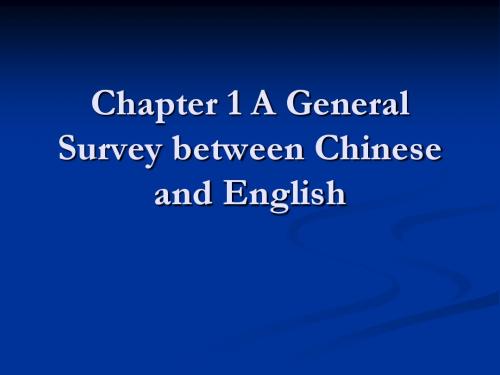
四、英汉语言不同的暗喻和联想
联想意义是语言符号唤起的联想或是所给予的暗示, 或是其内涵、外延对读者产生的印象。如:圣地 (holy land)对不同的人就有不同的联想,基督徒 想到的是耶路撒冷,佛教徒会想到西方净土,如 来佛住的地方,伊斯兰教徒则会想到他们的麦加。 e.g. A man is a wall. Her boyfriend is a transient cloud. 同一个词在汉英两种语言里所产生的联想有类似的、 有不同或是完全相反的,这就造成了汉英对译时 的矛盾。
Chapter 1 A General Survey between Chinese and English
Chinese Phonetics(语音) Literal Signs (文字符号) 59symbols Pictographs (象形文字)
English 48symbols Spelling (拼音文字)
b. 观察事物的角度和联想不同
walking dictionary 活字典 Close the door after you. 随手关门。 chair days 暮年 odd fish 怪物 stop watch 跑表(跑步时测速度用的表) sea dragon 海马 shade trees行道树 wet snow 雨夹雪 small talk 家常话
5. 绿与green
green old age 老当益壮 green table 赌桌 green food 绿色食品 greenhouse 温室 green finger 园艺技能 green apple 青苹果 a green hand 新手 green room 演员休息室 green wound 未愈合的伤口 green power 金钱的力量 green with envy 十分嫉妒
跨文化交际技巧修订版课文翻译
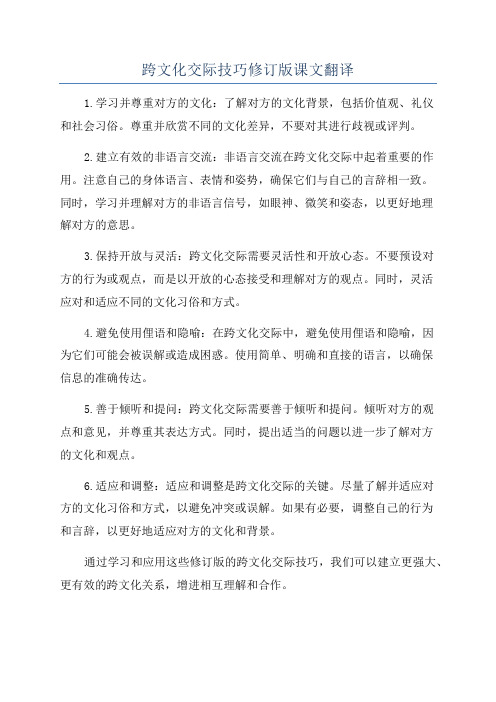
跨文化交际技巧修订版课文翻译
1.学习并尊重对方的文化:了解对方的文化背景,包括价值观、礼仪
和社会习俗。
尊重并欣赏不同的文化差异,不要对其进行歧视或评判。
2.建立有效的非语言交流:非语言交流在跨文化交际中起着重要的作用。
注意自己的身体语言、表情和姿势,确保它们与自己的言辞相一致。
同时,学习并理解对方的非语言信号,如眼神、微笑和姿态,以更好地理
解对方的意思。
3.保持开放与灵活:跨文化交际需要灵活性和开放心态。
不要预设对
方的行为或观点,而是以开放的心态接受和理解对方的观点。
同时,灵活
应对和适应不同的文化习俗和方式。
4.避免使用俚语和隐喻:在跨文化交际中,避免使用俚语和隐喻,因
为它们可能会被误解或造成困惑。
使用简单、明确和直接的语言,以确保
信息的准确传达。
5.善于倾听和提问:跨文化交际需要善于倾听和提问。
倾听对方的观
点和意见,并尊重其表达方式。
同时,提出适当的问题以进一步了解对方
的文化和观点。
6.适应和调整:适应和调整是跨文化交际的关键。
尽量了解并适应对
方的文化习俗和方式,以避免冲突或误解。
如果有必要,调整自己的行为
和言辞,以更好地适应对方的文化和背景。
通过学习和应用这些修订版的跨文化交际技巧,我们可以建立更强大、更有效的跨文化关系,增进相互理解和合作。
跨文化交际-其他要点翻译
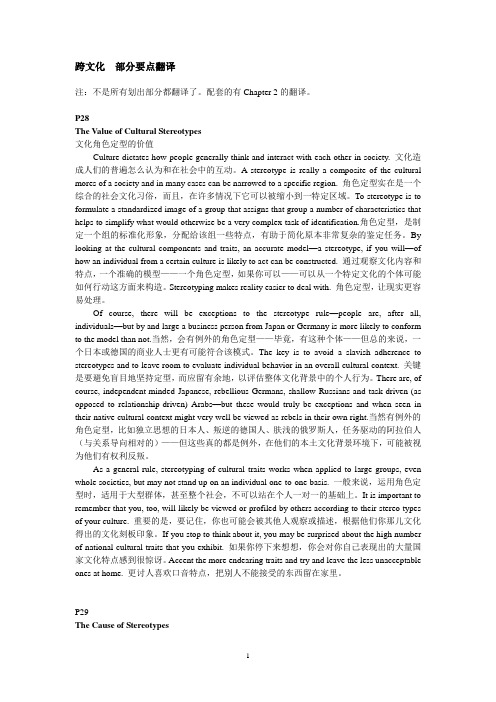
跨文化部分要点翻译注:不是所有划出部分都翻译了。
配套的有Chapter 2的翻译。
P28The Value of Cultural Stereotypes文化角色定型的价值Culture dictates how people generally think and interact with each other in society.文化造成人们的普遍怎么认为和在社会中的互动。
A stereotype is really a composite of the cultural mores of a society and in many cases can be narrowed to a specific region.角色定型实在是一个综合的社会文化习俗,而且,在许多情况下它可以被缩小到一特定区域。
To stereotype is to formulate a standardized image of a group that assigns that group a number of characteristics that helps to simplify what would otherwise be a very complex task of identification.角色定型,是制定一个组的标准化形象,分配给该组一些特点,有助于简化原本非常复杂的鉴定任务。
By looking at the cultural components and traits, an accurate model—a stereotype, if you will—of how an individual from a certain culture is likely to act can be constructed.通过观察文化内容和特点,一个准确的模型——一个角色定型,如果你可以——可以从一个特定文化的个体可能如何行动这方面来构造。
新编跨文化交际英语1-10课后翻译

Unit 2 Page 60Unit 3 Page 96Unit 5 Page 175Unit 6 Page 2158Translation如果接受这样的信念,认为以往的存在状况影响着我们对现实的看法,并且接受相应的原则,认为每个人都有着相似的但又不完全一样的个人经历,那么,随之就得到这样的结论:另一个人对宇宙的描述不一定会和我们对宇宙的描述完全一样。
然而,我们大多数人似乎仍认为我们自己感知事物的方法是唯一正确的。
我们常常忽略感知的差异,并且断定,如果一个人不知道巴比罗•毕加索是有史以来最伟大的艺术家,他简直就不懂艺术。
实际上,他很可能有着不同的经历,对他来说,什么是伟大的艺术跟我们对于艺术的感知或许并不一致。
在我们的日常活动中,感知差异常常出现在不同的群体之间。
不同年代的人、不同少数民族、不同职业和不同文化有着相冲突的价值观念和目标,这些都影响着他们对于现实的感知和解释。
我们的文化是导致感知不一致的主要因素。
文化影响着我们对于现实看法的形成。
因此,它在跨文化交际中起着一种主导作用。
我们的文化以各种方式告诉我们,怎样去判断别人,使用什么标准去做判断。
这样评价的危险在于它们常常是不真实的,武断的并导致误解的。
相信并在行为中表现出仿佛只有我们和我们的文化才发现了最真实而且是唯一的标准,对世界持这样的看法是极其天真幼稚的。
9Translation身处异域文化的人们总会面临着这样一个问题,即为了适应当地人的信仰、价值观、准则和社会规范,到底需要在多大程度上改变自己的行为举止呢?在交往中谁有责任把文化差异考虑在内?是应该让来访者、新来的人或旅居者调整自己的行为以适应当地文化,还是让当地人改变交流方式,从而为初来乍到的人们提供便利?人们必须多大程度地改变自己文化的信仰、价值观、准则和社会行为来以适应主导文化的模式呢?俗话说“入乡随俗”,很明显,这让改变的重任落在了新来者的身上。
话虽很有道理,但并不能适用于所有情况。
新编跨文化交际课后翻译中英对照
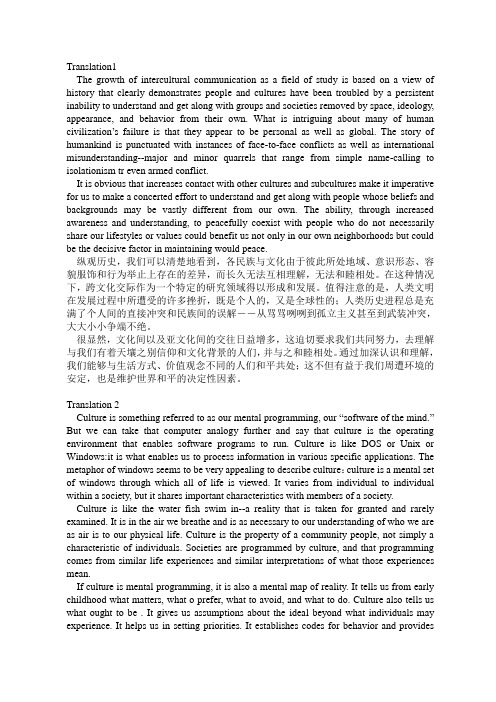
Translation1The growth of intercultural communication as a field of study is based on a view of history that clearly demonstrates people and cultures have been troubled by a persistent inability to understand and get along with groups and societies removed by space, ideology, appearance, and behavior from their own. What is intriguing about many of human civilization’s failure is that they appear to be personal as well as global. The story of humankind is punctuated with instances of face-to-face conflicts as well as international misunderstanding--major and minor quarrels that range from simple name-calling to isolationism tr even armed conflict.It is obvious that increases contact with other cultures and subcultures make it imperative for us to make a concerted effort to understand and get along with people whose beliefs and backgrounds may be vastly different from our own. The ability, through increased awareness and understanding, to peacefully coexist with people who do not necessarily share our lifestyles or values could benefit us not only in our own neighborhoods but could be the decisive factor in maintaining would peace.纵观历史,我们可以清楚地看到,各民族与文化由于彼此所处地域、意识形态、容貌服饰和行为举止上存在的差异,而长久无法互相理解,无法和睦相处。
跨文化交际课文翻译
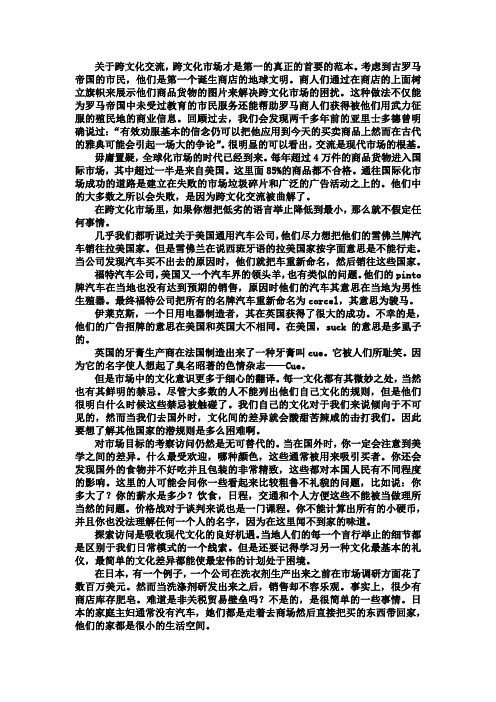
关于跨文化交流,跨文化市场才是第一的真正的首要的范本。
考虑到古罗马帝国的市民,他们是第一个诞生商店的地球文明。
商人们通过在商店的上面树立旗帜来展示他们商品货物的图片来解决跨文化市场的困扰。
这种做法不仅能为罗马帝国中未受过教育的市民服务还能帮助罗马商人们获得被他们用武力征服的殖民地的商业信息。
回顾过去,我们会发现两千多年前的亚里士多德曾明确说过:“有效劝服基本的信念仍可以把他应用到今天的买卖商品上然而在古代的雅典可能会引起一场大的争论”。
很明显的可以看出,交流是现代市场的根基。
毋庸置疑,全球化市场的时代已经到来。
每年超过4万件的商品货物进入国际市场,其中超过一半是来自美国。
这里面85%的商品都不合格。
通往国际化市场成功的道路是建立在失败的市场垃圾碎片和广泛的广告活动之上的。
他们中的大多数之所以会失败,是因为跨文化交流被曲解了。
在跨文化市场里,如果你想把低劣的语言举止降低到最小,那么就不假定任何事情。
几乎我们都听说过关于美国通用汽车公司,他们尽力想把他们的雪佛兰牌汽车销往拉美国家。
但是雪佛兰在说西班牙语的拉美国家按字面意思是不能行走。
当公司发现汽车买不出去的原因时,他们就把车重新命名,然后销往这些国家。
福特汽车公司,美国又一个汽车界的领头羊,也有类似的问题。
他们的pinto 牌汽车在当地也没有达到预期的销售,原因时他们的汽车其意思在当地为男性生殖器。
最终福特公司把所有的名牌汽车重新命名为corcel,其意思为骏马。
伊莱克斯,一个日用电器制造者,其在英国获得了很大的成功。
不幸的是,他们的广告招牌的意思在美国和英国大不相同。
在美国,suck的意思是多虱子的。
英国的牙膏生产商在法国制造出来了一种牙膏叫cue。
它被人们所耻笑。
因为它的名字使人想起了臭名昭著的色情杂志——Cue。
但是市场中的文化意识更多于细心的翻译。
每一文化都有其微妙之处,当然也有其鲜明的禁忌。
尽管大多数的人不能列出他们自己文化的规则,但是他们很明白什么时候这些禁忌被触碰了。
跨文化商务交际Unit 2 课文1参考译文(彭炳铭)
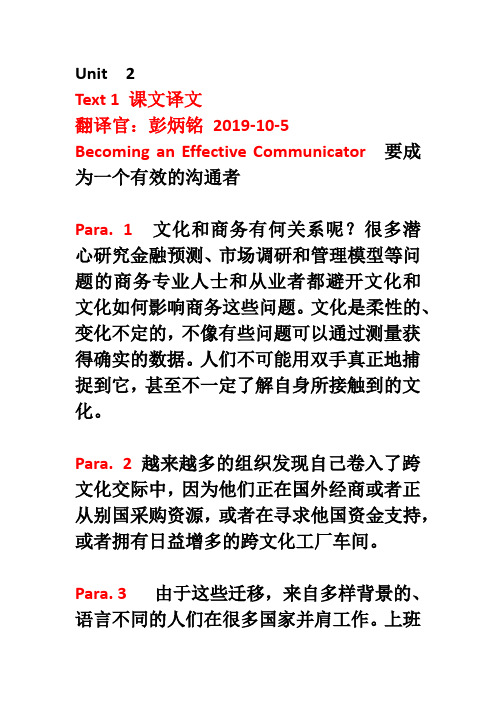
Unit 2Text 1 课文译文翻译官:彭炳铭2019-10-5Becoming an Effective Communicator 要成为一个有效的沟通者Para. 1 文化和商务有何关系呢?很多潜心研究金融预测、市场调研和管理模型等问题的商务专业人士和从业者都避开文化和文化如何影响商务这些问题。
文化是柔性的、变化不定的,不像有些问题可以通过测量获得确实的数据。
人们不可能用双手真正地捕捉到它,甚至不一定了解自身所接触到的文化。
Para. 2 越来越多的组织发现自己卷入了跨文化交际中,因为他们正在国外经商或者正从别国采购资源,或者在寻求他国资金支持,或者拥有日益增多的跨文化工厂车间。
Para. 3由于这些迁移,来自多样背景的、语言不同的人们在很多国家并肩工作。
上班时的跨文化沟通不再是遥远未来的目标,而是眼下此时此刻必需的事情。
Para. 4 跨文化沟通能力被广泛地认为是一个人在既定环境里其行为是否恰当和有效的一种印象。
通常工作能力被认为是一种熟练的行为能力。
Para. 5 恰当(appropriateness)就意味着不能违反那些关系中重要的规则、行为规范和期望。
效能(effectiveness)是指相对于成本和替代物而言的重要目标的实现或报酬的获得。
有了这两个标准,在跨文化环境中的沟通才是令人满意的。
只有那些既恰当又有效的国际商人才能达到跨文化最佳商务沟通者的标准要求。
下面例子将说明恰当与效能的区别。
布赖恩.霍尔兹(Brian Holtz)是一个美国商人,被公司派到泰国做公司的办公室主任。
塔里先生(Thani)是公司泰国曼谷分部的重要的副经理,最近上班总是迟到。
霍尔兹不得不决定如何处理这一问题。
经过深思熟虑,他有四种策略:(1)私下找塔里问缘由并告诉他上班要准时;(2)忽略这个问题不管;(3)下次再迟到就公开训斥他;(4)私下讨论时,建议说自己在帮他找一个助理来处理其部下上班迟到的问题,并征求他的意见:如何处理。
新编跨文化交际英语教程课文翻译
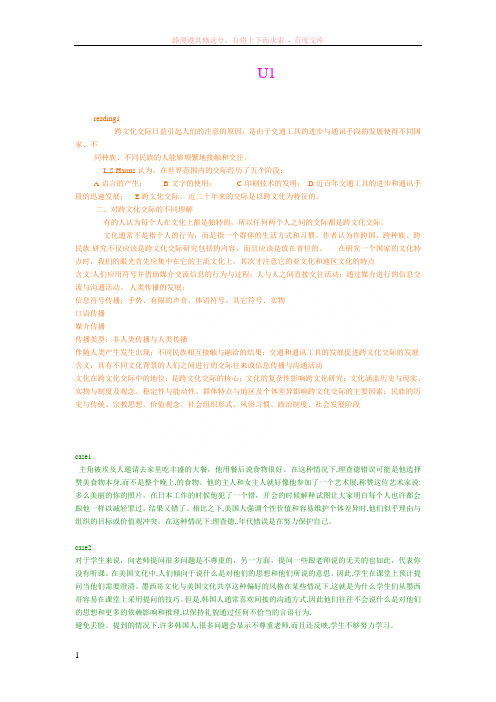
U1reading1跨文化交际日益引起人们的注意的原因:是由于交通工具的进步与通讯手段的发展使得不同国家、不同种族、不同民族的人能够频繁地接触和交往。
L.S.Harms认为,在世界范围内的交际经历了五个阶段:A语言的产生; B文字的使用; C印刷技术的发明; D近百年交通工具的进步和通讯手段的迅速发展; E跨文化交际。
近二十年来的交际是以跨文化为特征的。
二、对跨文化交际的不同理解有的人认为每个人在文化上都是独特的,所以任何两个人之间的交际都是跨文化交际。
文化通常不是指个人的行为,而是指一个群体的生活方式和习惯。
作者认为作跨国、跨种族、跨民族.研究不仅应该是跨文化交际研究包括的内容,而且应该是放在首位的。
在研究一个国家的文化特点时,我们的眼光首先应集中在它的主流文化上,其次才注意它的亚文化和地区文化的特点含义:人们应用符号并借助媒介交流信息的行为与过程;人与人之间直接交往活动;通过媒介进行的信息交流与沟通活动。
人类传播的发展:信息符号传播:手势、有限的声音、体语符号、其它符号、实物口语传播媒介传播传播类型:非人类传播与人类传播伴随人类产生发生出现;不同民族相互接触与融洽的结果;交通和通讯工具的发展促进跨文化交际的发展含义:具有不同文化背景的人们之间进行的交际往来或信息传播与沟通活动文化在跨文化交际中的地位:是跨文化交际的核心;文化的复杂性影响跨文化研究;文化涵盖历史与现实、实物与制度及观念、稳定性与能动性、群体特点与地区及个体差异影响跨文化交际的主要因素:民族的历史与传统、宗教思想、价值观念、社会组织形式、风俗习惯、政治制度、社会发展阶段case1主角被埃及人邀请去家里吃丰盛的大餐,他用餐后说食物很好。
在这种情况下,理查德错误可能是他选择赞美食物本身,而不是整个晚上,的食物。
他的主人和女主人就好像他参加了一个艺术展,称赞这位艺术家说:多么美丽的你的照片。
在日本工作的时候他犯了一个错,开会的时候解释试图让大家明白每个人也许都会跟他一样以减轻罪过,结果又错了。
新编跨文化交际【warm up】 原文及翻译
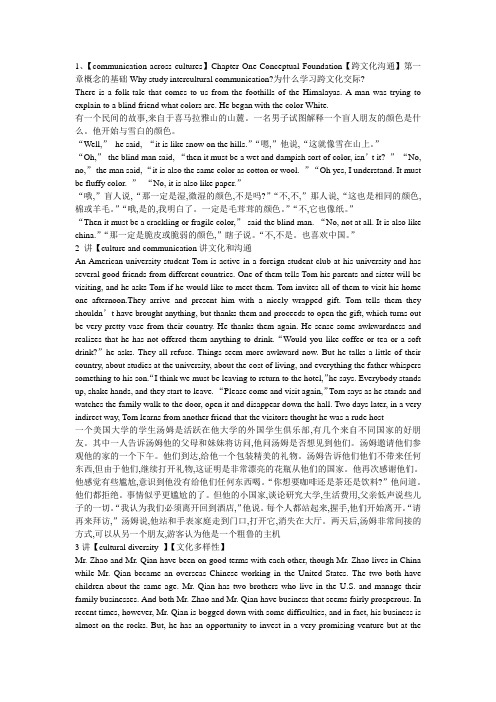
1、【communication across cultures】Chapter One Conceptual Foundation【跨文化沟通】第一章概念的基础Why study intercultural communication?为什么学习跨文化交际?There is a folk tale that comes to us from the foothills of the Himalayas. A man was trying to explain to a blind friend what colors are. He began with the color White.有一个民间的故事,来自于喜马拉雅山的山麓。
一名男子试图解释一个盲人朋友的颜色是什么。
他开始与雪白的颜色。
“Well,”he said, “it is like snow on the hills.”“嗯,”他说,“这就像雪在山上。
”“Oh,”the blind man said, “then it must be a wet and dampish sort of color, isn’t it? ”“No, no,”the man said, “it is also the same color as cotton or wool. ”“Oh yes, I understand. It must be fluffy color. ”“No, it is also like paper.”“哦,”盲人说,“那一定是湿,微湿的颜色,不是吗?”“不,不,”那人说,“这也是相同的颜色,棉或羊毛。
”“哦,是的,我明白了。
一定是毛茸茸的颜色。
”“不,它也像纸。
”“Then it must be a crackling or fragile color,”said the blind man. “No, not at all. It is also like china.”“那一定是脆皮或脆弱的颜色,”瞎子说。
大学英语跨文化交际教程翻译 杨晓萍 陶岳炼 主编
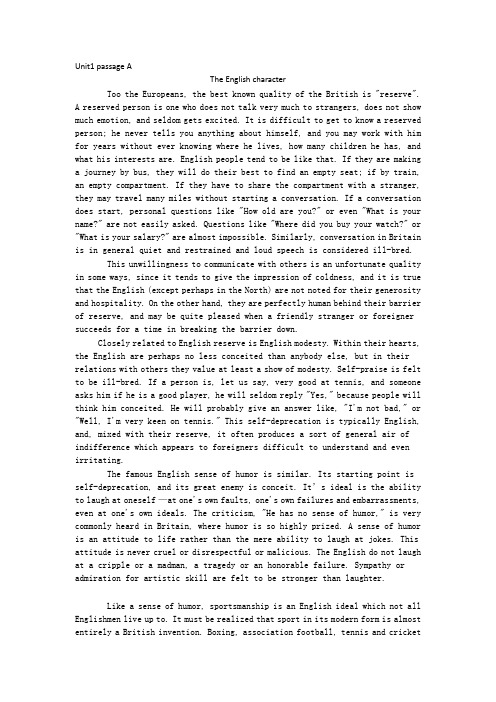
Unit1 passage AThe English characterToo the Europeans, the best known quality of the British is "reserve".A reserved person is one who does not talk very much to strangers, does not show much emotion, and seldom gets excited. It is difficult to get to know a reserved person; he never tells you anything about himself, and you may work with him for years without ever knowing where he lives, how many children he has, and what his interests are. English people tend to be like that. If they are making a journey by bus, they will do their best to find an empty seat; if by train, an empty compartment. If they have to share the compartment with a stranger, they may travel many miles without starting a conversation. If a conversation does start, personal questions like "How old are you?" or even "What is your name?" are not easily asked. Questions like "Where did you buy your watch?" or "What is your salary?" are almost impossible. Similarly, conversation in Britain is in general quiet and restrained and loud speech is considered ill-bred.This unwillingness to communicate with others is an unfortunate quality in some ways, since it tends to give the impression of coldness, and it is true that the English (except perhaps in the North) are not noted for their generosity and hospitality. On the other hand, they are perfectly human behind their barrier of reserve, and may be quite pleased when a friendly stranger or foreigner succeeds for a time in breaking the barrier down.Closely related to English reserve is English modesty. Within their hearts, the English are perhaps no less conceited than anybody else, but in their relations with others they value at least a show of modesty. Self-praise is felt to be ill-bred. If a person is, let us say, very good at tennis, and someone asks him if he is a good player, he will seldom reply "Yes," because people will think him conceited. He will probably give an answer like, "I'm not bad," or "Well, I'm very keen on tennis." This self-deprecation is typically English, and, mixed with their reserve, it often produces a sort of general air of indifference which appears to foreigners difficult to understand and even irritating.The famous English sense of humor is similar. Its starting point is self-deprecation, and its great enemy is conceit. It’s ideal is the ability to laugh at oneself —at one's own faults, one's own failures and embarrassments, even at one's own ideals. The criticism, "He has no sense of humor," is very commonly heard in Britain, where humor is so highly prized. A sense of humor is an attitude to life rather than the mere ability to laugh at jokes. This attitude is never cruel or disrespectful or malicious. The English do not laugh at a cripple or a madman, a tragedy or an honorable failure. Sympathy or admiration for artistic skill are felt to be stronger than laughter.Like a sense of humor, sportsmanship is an English ideal which not all Englishmen live up to. It must be realized that sport in its modern form is almost entirely a British invention. Boxing, association football, tennis and cricketwere all first organized and given rules in Britain. Rules are the essence of sport, and sportsmanship is the ability to practise a sport in obedience to its rules, while also showing generosity to one's opponent and good temper in defeat. Moreover, sportsmanship as an ideal is applied to life in general. One of the most elementary rules of life is "never hit a man when he's down"─in other words, never take advantage of another person's misfortune. English school-boys often show this sense of sportsmanship to a surprisingly high degree in their relations with each other.译文:对于其他欧洲人来说,英国人最著名的特点是“谨慎”。
跨文化交际英语阅读教程所学课文翻译
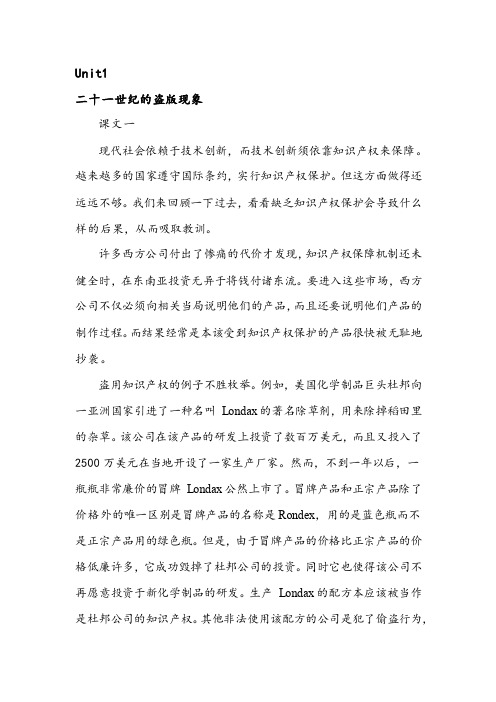
Unit1二十一世纪的盗版现象课文一现代社会依赖于技术创新,而技术创新须依靠知识产权来保障。
越来越多的国家遵守国际条约,实行知识产权保护。
但这方面做得还远远不够。
我们来回顾一下过去,看看缺乏知识产权保护会导致什么样的后果,从而吸取教训。
许多西方公司付出了惨痛的代价才发现,知识产权保障机制还未健全时,在东南亚投资无异于将钱付诸东流。
要进入这些市场,西方公司不仅必须向相关当局说明他们的产品,而且还要说明他们产品的制作过程。
而结果经常是本该受到知识产权保护的产品很快被无耻地抄袭。
盗用知识产权的例子不胜枚举。
例如,美国化学制品巨头杜邦向一亚洲国家引进了一种名叫Londax的著名除草剂,用来除掉稻田里的杂草。
该公司在该产品的研发上投资了数百万美元,而且又投入了2500万美元在当地开设了一家生产厂家。
然而,不到一年以后,一瓶瓶非常廉价的冒牌Londax公然上市了。
冒牌产品和正宗产品除了价格外的唯一区别是冒牌产品的名称是Rondex,用的是蓝色瓶而不是正宗产品用的绿色瓶。
但是,由于冒牌产品的价格比正宗产品的价格低廉许多,它成功毁掉了杜邦公司的投资。
同时它也使得该公司不再愿意投资于新化学制品的研发。
生产Londax的配方本应该被当作是杜邦公司的知识产权。
其他非法使用该配方的公司是犯了偷盗行为,就像盗取了杜邦公司的机器或者该公司的其他财产一样。
不光是产品,在亚洲市场上保护一个品牌也曾经是几乎不可能的事。
就连Kellogg’s玉米片的生产商Kellogg’s公司也发现自己的产品被山寨:Kongal 牌玉米条,连包装也几乎一模一样。
不幸的是,和杜邦公司的事件一样,Kellogg’s 公司成功惩罚侵权者的几率几乎为零,因为当地的法律不承认知识产权保护的概念。
幸好,在经过许多轮世贸组织的谈判后,情况大为改观。
然而,跨国公司必须保持警惕,以防被侵权。
总有人试图从别人的研发、投资、商誉中牟利。
如果成果得不到法律保护,创新就是空话。
跨文化交际翻译版
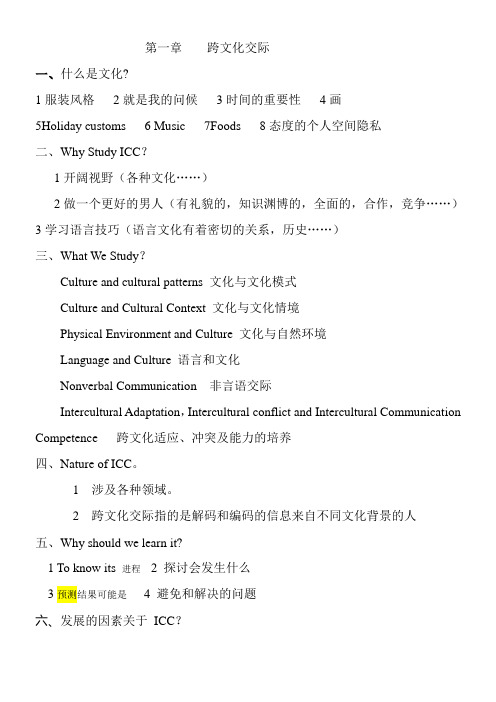
第一章跨文化交际一、什么是文化?1服装风格2就是我的问候3时间的重要性4画5Holiday customs 6 Music 7Foods 8态度的个人空间隐私二、Why Study ICC?1开阔视野(各种文化……)2做一个更好的男人(有礼貌的,知识渊博的,全面的,合作,竞争……)3学习语言技巧(语言文化有着密切的关系,历史……)三、What We Study?Culture and cultural patterns 文化与文化模式Culture and Cultural Context 文化与文化情境Physical Environment and Culture 文化与自然环境Language and Culture 语言和文化Nonverbal Communication 非言语交际Intercultural Adaptation,Intercultural conflict and Intercultural Communication Competence 跨文化适应、冲突及能力的培养四、Nature of ICC。
1 涉及各种领域。
2 跨文化交际指的是解码和编码的信息来自不同文化背景的人五、Why should we learn it?1 To know its 进程2 探讨会发生什么3预测结果可能是 4 避免和解决的问题六、发展的因素关于ICC?1技术发展 2 Globalization 全球化 3 人口迁移七、Globalization。
1 全球化的定义?2 戴安娜公主逝世.An English princess with an Egyptian boyfriend crashes in French tunnel, driving a German car with a Dutch engine, driven by a Belgian (比利时人) who was drunk on Scottish whisky, followed closely by Italian Paparazzi, on Japanese motorcycles; treated by an American doctor, using Brazilian Medicine.英国公主与埃及男友坠毁在法国的隧道,驾驶一辆德国汽车与发动机驱动的荷兰,比利时(比利时人)谁喝苏格兰威士忌,紧随其后的是意大利狗仔队,日本摩托车;治疗的美国医生使用药物,巴西。
跨文化交际课文翻译

Speaki ng Englis h with a Japane se mind 日本人在达到上学年龄后就要学英语,这些人在学会英语之后就可能用英语进行对外交流,但是他们所使用的英语要受到他们本民族的语言和文化的影响。
因此这就会造成困扰和误解在与其他用英语的人交流时。
AM,当他作为索尼公司的首席执行官时,在一次给美国的商学会做报告时他指出了这两种语言的明显差异。
他举了一个例子,一个美国商人向他的一个日本生意上的伙伴提议了一项计划。
可是当美国人完成时,日本人才开始谈论这个项目听起来多么有趣并且他们公司也有同样的想法。
美国人认为这个项目肯定会被接受。
但是随着辩论的拖延,美国人的关注也开始减弱,然后日本人说,不管怎样。
AM告诫说,接下来就是你要仔细听的时候了。
因为真正的回答是在那个词语的后面。
他经常告诫他的部下官员要用一种大多数的使用英语的人都习惯的方式说话,如果他想被别人理解。
他还告诫说,在日本你可能是大多数,但是到了国外你就是一小部分。
要想用一种大多数人都能最大限度的理解你的方式说话需要更多的语法知识和大量的词汇。
你必须对你所谈话的那个人的交流方式,社交礼仪,价值观等等很熟悉。
日本人的说话顺序正好和说英语的人相反。
甚至就是一个非常简单的句子,比如英国人会说,你得带伞因为要下雨。
而日本人会说,因为会下雨所以你要带伞。
不管这种正常的表达方式的顺序是否会控制想法顺序还是什么,日本人这种用不同顺序的表达信息的方式会让那些说英语的国家的人且对日本语言不了解的人感到困惑。
另一个例子就是,一些说英语的日本人和美国的一些领导举行卫星电视会议来讨论两国间的经济和贸易关系。
日本的参会者说着流利的英语,同时会被翻译成日语以供那些不懂得英语的人理解。
新编跨文化交际英语教程1~7单元翻译
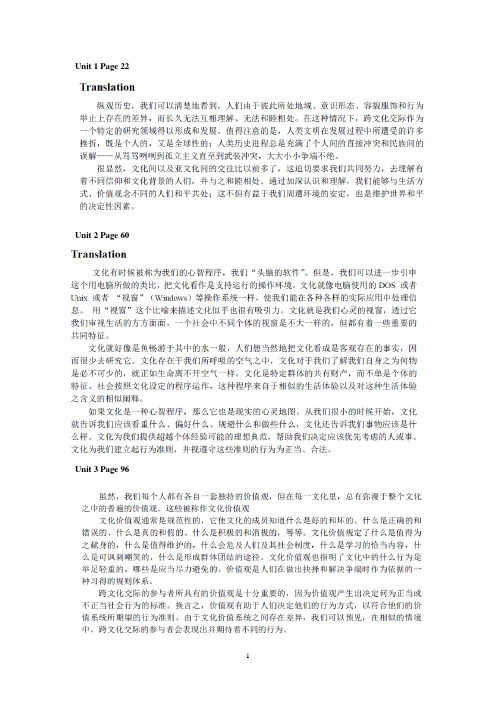
Unit 2 Page 60 Unit 3 Page 96Unit 5 Page 175 Unit 6 Page 215Case 2A common cultural misunderstanding in classes involves conflicts between what is said to be direct communication style and indirect communication style. In American culture, people tend to say what is on their minds and to mean what they say. Therefore, students in class are expected to ask questions when they need clarification. Mexican culture shares this preference of style with American culture in some situations, and that‘s why the students from Mexico readily adopted the techniques of asking questions in class. However, Korean people generally prefer indirect communication style, and therefore they tend to not say what is on their minds and to rely more on implications and inference, so as to be polite and respectful and avoid losing face through any improper verbal behavior. As is mentioned in the case, to many Koreans, numerous questions would show a disrespect for the teacher, and would also reflect that the student has not studied hard enough.Case 3The conflict here is a difference in cultural values and beliefs. In the beginning, Mary didn’t realize that her Dominican sister saw her as a member of the family, literally. In the Dominican view, family possessions are shared by everyone of the family. Luz was acting as most Dominican sisters would do in borrowing without asking every time. Once Mary understood that there was a different way of looking at this, she would become more accepting. However, she might still experience the same frustration when this happened again. She had to find ways to cope with her own emotional cultural reaction as well as her practical problem (the batteries running out).Case 6When a speaker says something to a hearer, there are at least three kinds ofmeanings involved: utterance meaning, speaker’s meaning and hearer’s meaning. In the dialogue, when Litz said ‘How long is she going to stay?’ she meant to say that if she knew how long her mother-in-law was going to stay in Finland, she would be able to make proper arrangements for her, such as taking her out to do some sightseeing. However, her mother-in-law overheard the conversation, and took Litz’s question to mean “Litz does not want me to stay for long”. From the Chinese point of view, it seems to be inappropriate for Litz to ask such a question just two days after her mother-in-law’s arrival. If she feels she has to ask the question, it would be better to ask some time later and she should not let her mother-in-law hear it.Case 7Keiko insists on giving valuable gifts to her college friends, because in countries like Japan, exchanging gifts is a strongly rooted social tradition. Should you receive a gift, and don’t have one to offer in return, you will probably create a crisis. If not as serious as a crisis, one who doesn’t offer a gift in return may be considered rude or impolite. Therefore, in Japan, gifts are a symbolic way to show appreciation, respect, gratitude and further relationship.Keiko obviously has taken those used items from Mary, Ed and Marion as gifts, for she probably doesn’t know that Americans frequently donate their used household items to church or to the community. Mary, Ed and Marion would never consider those used household items given to Keiko as gifts. No wonder they felt very uncomfortable when they received valuable gifts in return.Case 10In Japan, a company is often very much like a big family, in which the manger(s) will take good care of the employees and the employees are expected to devote themselves to the development of the company and, if it is necessary, to sacrifice their own individual interests for the interests of the company, from which, in the long run, the employees will benefit greatly. But for the French, a company is just a loosely- knit social organization wherein individuals are supposed to take care of themselves and their families. Moreover, the way the French make decisions in the family might also be different from the typical Japanese one, which may not often involve females and the power to decide usually lies with the dominating male. As there are such cultural differences between the Japanese and the French, Mr. Legrand’s decision made Mr. Tanaka feel dumbfounded.Case 12In this case, it seems that the Chinese expectations were not fulfilled. First, having two people sharing host responsibilities could be somewhat confusing to the hierarchically minded Chinese. Second, because age is often viewed as an indication of seniority, the Chinese might have considered the youth of their Canadian hosts as slight to their own status. Third, in China, it is traditional for the host to offer a welcome toast at the beginning of the meal, which is the reciprocated by the guests; by not doing so, the Canadian might be thought rude. The abrupt departure of the Chinese following the banquet was probably an indication that they were not pleased with the way they were treated. The Canadians’ lack of understanding of the Chinese culture and the Chinese ways of communication clearly cost them in their business dealings with the visiting delegation.Case 17When these two men separate, they may leave each other with very different impressions.Mr Richardson is very pleased to have made the acquaintance of Mr Chu and feels they have gotten off to a very good start. They have established their relationship on a first-name basis and Mr Chu’s smile seemed to indicate that he will be friendly and easy to do business with. Mr Richardson is particularly pleased that he had treated Mr Chu with respect for his Chinese background by calling him Hon-fai rather than using the western name, David, which seemed to him an unnecessary imposition of western culture.In contrast, Mr Chu feels quite uncomfortable with Mr Richardson. He feels it will be difficult to work with him, and that Mr Richardson might be rather insensitive to cultural differences. He is particularly bothered that, instead of calling him David or Mr Chu, Mr Richardson used his given name, Hon-fai, the name rarely used by anyone, in fact. It was this embarrassment which caused him to smile. He would feel more comfortable if they called each other Mr Chu and Mr Richardson. Nevertheless, when he was away at school in North America he learned that Americans feel uncomfortable calling people Mr for any extended period of time. His solution was to adopt a western name. He chose David for use in such situations.Case 19Talking about what’s wrong is not easy for people in any culture, but people in high-context countries like China put high priority on keeping harmony, preventing anyone from losing face, and nurturing the relationship. It seems that Ron Kelly had to learn a different way of sending message when he was in China. At home in Canada he would have gone directly to the point. But in China, going directly to the problem with someone may suggest that he or she has failed to live up to his or her responsibility and the honor of his or her organization is in question. In high-context cultures like China, such a message is serious and damaging. In low-context cultures, however, the tendency is just to “spit it out”, to get it into words and worry about the result later. Senders of unwelcome messages use objective facts, assuming, as with persuasion, that facts are neutral, instrumental, and impersonal. Indirectness is often the way members of high-context cultures choose to communicate about a problem. Case 21Sometimes our best intentions can lead to breakdowns (故障)in cross-cultural communication. For example, one of the very common manners of touching --- handshaking --- may result in conflict when performed with no consideration of cultural differences. Among middle-class North American men, it is customary to shake hands as a gesture of friendship. When wanting to communicate extra friendliness, a male in the United States may, while shaking hands, grasp with his left hand his friend’s right arm. However, to people of Middle Eastern countries, the left hand is profane (亵渎的) and touching someone with it is highly offensive. Therefore, in Vernon’s eyes, Kenneth was actually an extremely offensive message to him. Case 22In Puerto Rican culture, as in some other Latin American and Eastern cultures, it is not right for a child to keep an eye-contact with an adult who is accusing him or her, while in the United States, failing of meeting other person’s eye accusing him or her would be taken as a sign of guiltiness. As the principal knew little about this cultural difference in using eye-contact, he decided that the girl must be guilty. Generallyspeaking, avoiding eye-contact with the other(s) is often considered as an insult in some cultures, but may signify respect for authority and obedience in other cultures. Case 25For people from the American culture and western European cultures, one’s time should be scheduled into segments or compartments which are to be kept discrete from one another. They prefer to do one thing at a time. They will be annoyed when they have made an appointment with somebody, only to find a lot of other things going on at the same time. They don’t like to interrupt others and be interrupted by other while they are doing something. In contrast, people from many other cultures including the Chinese culture are more likely to operate with several people, ideas, or matters simultaneously. They are more easily distracted and subject to interruptions, which they would not usually mind very much. The miscommunication between Katherine and the director can be ascribed to their lack of knowledge about each other’s way of using time.In this case, to the Chinese director as well as many other Chinese people, it is natural to handle the other things which needed to be dealt with immediately. He may have thought that, in this way, he utilized the time best. But to Katherine and most Westerners, it’s quite different. They tend to do things strictly according to their schedule and appointments with others, which is their concept of using time best.高语境交流和低语境交流(由高到低排列)Japanese, Chinese, Korean, African American, Native American, Arab, Greek, Latin,Italian,English,Frech,Amercian,Scandinavian,German,German-Swiss。
- 1、下载文档前请自行甄别文档内容的完整性,平台不提供额外的编辑、内容补充、找答案等附加服务。
- 2、"仅部分预览"的文档,不可在线预览部分如存在完整性等问题,可反馈申请退款(可完整预览的文档不适用该条件!)。
- 3、如文档侵犯您的权益,请联系客服反馈,我们会尽快为您处理(人工客服工作时间:9:00-18:30)。
P288
安静为洞察你的谈话,清楚地了解你所接触的人们提供了机会。
倾听者在这些文化中也要直面说话者,并随意地提问。
在非直接的倾听文化中,例如,芬兰,日本,瑞典,人们以各种不同的方式倾听。
当说话者正在说话时,是不可以打断他的。
因为有礼貌也是倾听者的表现之一。
倾听者的价值
正如我们在其他地方提及过的,在远东的许多文化中,花在说话上的时间和价值是与那些重视交谈的文化大不相同的(中东,拉丁美洲,美国)。
日本是个国内文化相对统一的国家,因此大多数人都分享共同的经验。
这种共同性有助于一个人在没有语言交流的情况下理解他人的想法和感受。
罗马心理学家卡图曾以这样一句话来描述他对安静和倾听的价值的认识“我最活跃的时刻莫过于在我放空的时候。
”因此,安静常常比谈话更具价值。
在佛学中“有一种真理是无法用言语表达的”,想想说话、倾听和安静之间的联系。
而相比于阿拉伯谚语“你的嘴就是你的剑”,我们即可看出两种非常不同的侧重---一个支持安静,一个偏爱交谈。
非语言的交流和倾听
即使你所听到的非语言回应,也受文化影响。
在美国,如果某个人说话时发出“嗯,哼”的声音,那么这往往是想要引起人的注意。
在美非共同文化中,倾听者这方的辅助语言甚至被称为呼应。
当这种技能被使用,在说话者和倾听者之间便有了一种积极的互动,这种交互在大多数文化中,是没有被发现的。
眼神交流是另一种影响倾听过程的非语言行为。
在美国和其他西方文化中,一个好的倾听者,他/她往往专注于与说话者有直接的眼神交流。
但在许多亚洲文化和美印文化中,直接的眼对眼的接触是不好的习惯。
简言之,要成为一个优秀的倾听者,你需要知道哪些非语言行为是合适的,哪些是会妨碍交流的。
鼓励反馈
相互作用的自然交流将我们带入下一个话题:鼓励反馈。
反馈,是由接受信息的人所形成产生的信息---这种信息会被反馈给表达最初信息的那人。
这类信息也许是一个微笑,一句“不,谢谢”,甚至是完全的安静,没有任何表露出来的表情。
正如伍兹说过“反馈可以是语言的,非语言的或者二者皆有。
它可以是有意识的,也可以是无意为之。
”不管反馈的形式如何,它都使我们有机会在交流进行中做出定性判断。
这些判断会为你提供有用的数据,从而使你能够改正或调整你接下来要表达的信息。
